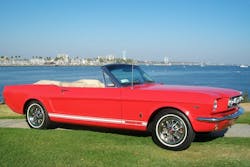In southern California in 1966, Danny Frechette’s neighbor bought a brand-new red Ford Mustang GT convertible. She got into some accidents and had it painted “disgusting yellow” for $29.95, he says.
A few years later she decided she didn’t want it, so Frechette’s father bought it from her for $500 in 1969. But his dad, Jean Roch Frechette, didn’t really use it, either. The car became a garage fixture, a workbench and a place for keeping Christmas ornaments. “It just got forgotten,” Danny says.
For years Jean promised to clean it up and fix it. “It just didn’t happen,” Danny says.
Danny now owns the collision repair shop that his dad retired from in 2001, JRF Collision Center in Bellflower, Calif. Danny thought it would be a fun idea to restore the Mustang as a Father’s Day gift, and as a way to recognize JRF Collision Center’s 25th anniversary.
“I called him, I says, ‘Get everything out and off of that car,’” Danny recalls.
Tears came to Jean’s eyes as the tow truck hauled the classic convertible back to the collision center for its restoration.
In April 2010, Danny and his staff got to work. First, they removed the 225-horsepower 289-cubic-inch V8 engine and the four-speed manual transmission. Then they put the car on a rotisserie and took off every nut and bolt.
The undercarriage parts were rusty and worn, so one of Danny’s friends helped him sandblast parts and powder coat them so they looked new.
After that, they put the suspension back on the car, and reinstalled all of the new equipment. The transmission and engine were also rebuilt.
The shop did the bodywork, as well, which took several months. The car was stripped completely down to metal using Aircraft paint remover. It was more expensive that way, but sandblasting can blow dust into cracks and crevices, Danny says.
While doing the bodywork, they saw all of the details from the original owner. For example, they noticed the Bondo that had been used on the hood in repairing previous damage. Their work included welding panels that had rust spots and removing every panel, which were primed and sealed. Back in 1966, the car was put together by hand, and that’s exactly what they did during the restoration.
“We wanted this vehicle to look like it did back in 1966 when it rolled off the showroom floor,” Danny says.
So there was never any doubt that the car would return to its original color. It was re-caulked, re-sealed and sprayed red. The Mustang also received a new interior, a new top, and new wiring.
The vehicle has a factory look, with disc brakes, fog lamps, and a Pony interior, which includes two-tone seats. “It has all the bells and whistles,” Danny says.
Danny put $35,000 to $40,000 into the car, and his crew worked more than 1,000 hours and a lot of Saturdays. Everyone on staff helped—including the secretary and office manager.
The Mustang was unveiled in June of 2011 at the shop’s 25th anniversary party. City officials, customers and the Chamber of Commerce showed up to celebrate. Danny’s family was there, too.
His father got to one knee and kissed the fender. His mom was crying.
“He’s in awe about it,” Danny says of his father, who now drives the car to shows, where it has won first-place awards. “Just the look on their face was well worth the wait.”
